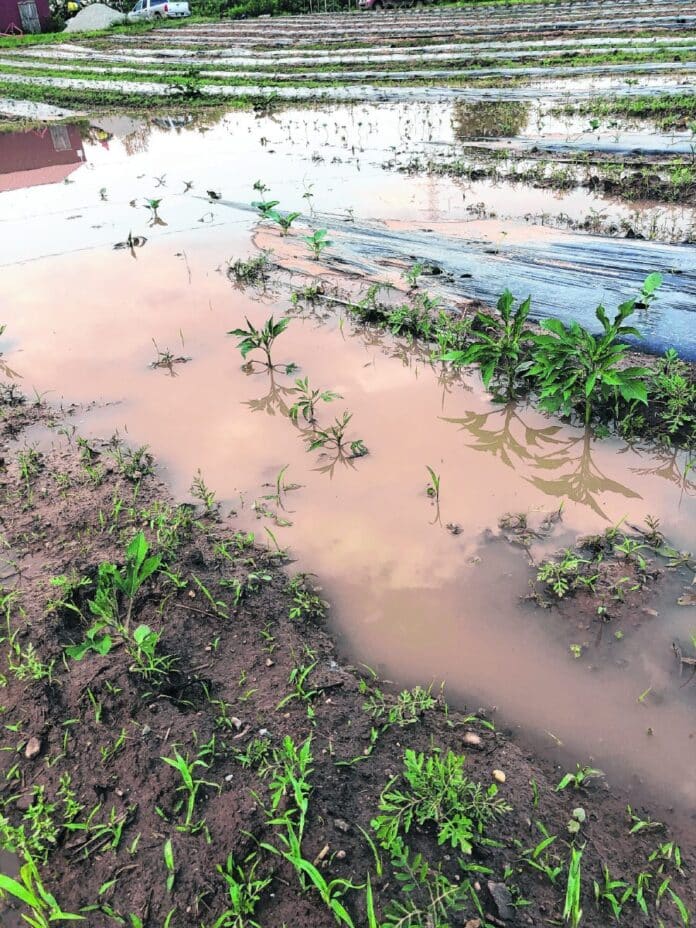
HANCOCK COUNTY — By around this time last year, Jon Sparks had finished planting all of his corn and soybeans.
He remembers the rest of Hancock County’s farmers being in a similar position.
“I know everybody was done by the end of May,” he said.
[sc:text-divider text-divider-title=”Story continues below gallery” ]
Click here to purchase photos from this galleryCurrently, he doesn’t have anything in the ground.
This year’s wet and unseasonably cold spring has the county’s planting season off to a slow start. As farmers await better weather, they’re also starting to weigh options for relief in the form of insurance and a recently announced aid package. The longer they go without planting, the smaller the yield and the more perilous the finances become.
The Indianapolis area had rain 15 out of the first 24 days of May, totaling more than 3½ inches, according to the National Weather Service. Most of the month’s minimum temperatures have been in the 40s and 50s.
“There’s a lot to getting a crop off to a good start,” Sparks said. “If it gets screwed up to start with, it’s probably going to have problems through the whole growing season.”
The National Weather Service’s forecast for the Indianapolis area Saturday through Wednesday predicts a chance of showers every day.
“There’s not a lot you can do other than wait for the weather to change and hope you can get a few days in,” Sparks said.
Sparks, who represents Hancock County and seven other counties on the Indiana Farm Bureau Board of Directors, said the best time to plant corn is during the last week of April and first couple weeks of May. After that, expected yields drop dramatically, he continued.
When deciding whether to take advantage of prevented-planting insurance, farmers have to weigh the potential provisions against cash rent obligations and funds already invested into planting season like seed, chemicals, fertilizer and equipment preparation, Sparks said.
“It’s an option, but it’s not necessarily one anyone would want to use,” he said. “…It’s a crapshoot, really.”
The aid package the U.S. Department of Agriculture announced Thursday gives farmers even more to think about when considering insurance claims, Sparks continued. Because the aid will be based on the acres farmers plant in 2019, they’ll be more inclined to plant in exchange for the assistance as opposed to seeking insurance for what they don’t put in the ground, he predicts.
Joe Paxton, a Hancock County farmer, said he’s planted 350 acres of corn and 350 acres of soybeans so far.
“But we got a lot yet to go,” he continued, adding he’s usually done planting by this time of year.
Paxton said much of the land he farms remains too wet to plant.
“Every time it almost gets dry enough, it rains again,” he said.
He wouldn’t call the situation dire just yet, but said it will be if current conditions persist two to three weeks from now.
Paxton said the most delayed planting season he can remember was in 1981, when crops weren’t in until June.
Roy Ballard, Purdue Extension Hancock County educator for agriculture and natural resources, said he saw a field of germinated corn for the first time on Wednesday, a sight he added should have been prevalent a couple weeks ago.
Planting should be about 85 percent complete by now, Ballard added. He said he’s heard estimates that it’s only at about 14 percent, which he described as optimistic.
“It’s just a really sad state of affairs,” Ballard said.
Corn and soybeans aren’t the only crops threatened by the slow start to planting season. Jonathan Lawler of Brandywine Creek Farms called the conditions “devastating” for his operation’s produce.
On Wednesday, Lawler said he had more than 190,000 plants waiting in a barn unable to go in the ground due to the wet soil and cool weather. The delay has been costing about $1,200 a day, he added.
By this time last year, the farm had second and third plantings under way, Lawler said. He’s been farming off and on for almost 20 years and said he’s never experienced a planting season like this.
The farm’s jalapeno peppers should have been planted around May 10, he continued. As June approaches, none have been able to go in the ground.
Brandywine Creek Farms donates a third of its produce. Last year, that amounted to about 860,000 pounds, Lawler said. Another third is sold into an affordable-access market and made available to consumers with limited incomes. The remaining third is sold at wholesale.
Lawler said the farm is under contract to plant 15,000 sweet potatoes for a community center that donates them to people with limited incomes. With the ground too wet to use a transplanter, workers planted 2,000 of the sweet potatoes by hand on Tuesday, he said.
Much of the Midwest is experiencing a similarly soggy and slow start to planting season. AccuWeather, a weather forecasting service provider, reported this week that corn and soybean planting remains behind schedule in 17 of 18 states compared to their 2014-2018 averages.
The service “predicts corn and soybean yields will fall below the USDA estimates for the season as wet weather persists throughout key corn- and soybean-producing states.”
The USDA projected a corn crop of 15 billion bushels, up from 2018’s 14.3 billion.
“However, AccuWeather meteorologists estimate the 2019 corn crop will yield 14.2 billion bushels,” according to the report.
AccuWeather goes on to cite a May 10 USDA report estimating a soybean yield of 4.15 billion bushels, down from last year’s record 4.54 billion. But AccuWeather estimates 4.1 billion bushels of soybeans in 2019.
As of May 20, corn planting in 18 key U.S. states is off almost 39 percent compared to the five-year average while soybean planting is off nearly 60 percent, according to AccuWeather.




